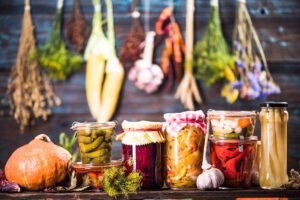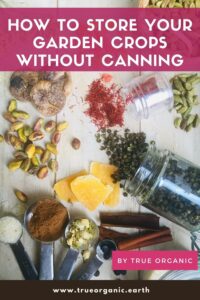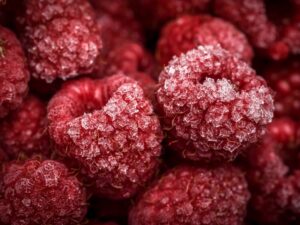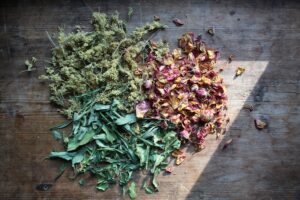March 30, 2022
How To Store Your Garden Crops Without Canning
How To Store Your Garden Crops Without Canning
If you’ve ever asked a friend, “What should I do with all these tomatoes?” while harvesting your summer garden, you’ve probably heard a resounding: “Can ‘em!”
But what if you don’t have the equipment, expertise, time, or counter space to make 20 cans of tomato sauce that sit in your pantry all year?
Great news: It’s absolutely possible to store your garden crops without the hassle of canning. In fact, there is a whole menu of options besides traditional canning that you can utilize to preserve fresh fruits, vegetables, herbs, and even flowers.
Let’s get one thing straight: we’re not anti-canning! It’s true that canning is a time-tested, high-volume, economical saving method, and it’s a fun annual activity for those who have the time. But it can also be expensive, complicated, and time-consuming. Just to begin canning, you need a whole swath of equipment and a heck of a lot of kitchen counter space.
We’re here to help with alternatives to canning that will keep your garden harvest ready-to-use in any season.
Get ready for tomato sauce in Fall, the spice of peppers in the cold of Winter, and recipe ingredients at your fingertips year-round!
We’ll go over the best vegetables for winter storage, easy ways to store crops long-term and short-term, and fun ways to preserve your harvest for winter for delicious meals even when your garden isn’t growing.
How To Preserve Your Harvest
 Freezing
Freezing
Don’t turn a cold shoulder to freezing your fresh garden produce! When done right, freezing preserves flavor and nutrients, and can majorly up your cooking game.
Tomatoes
While many people chop and cook down tomatoes for canning, you can freeze them whole! When you need tomatoes for a sauce, curry, or casserole recipe, you simply place them in a bowl of warm water and peel the skin off before adding them in. Another option is to freeze the tomatoes with the skin and then make sauce with them in the year when you have more time and aren’t overwhelmed by the garden’s bounty.
If you have a bit more time to invest during harvest, cut tomatoes into chunks to store. Yes, you can even cook your favorite tomato sauce for freezing.
Cooked Onions
Unprocessed onions don’t freeze well in their entirety (that’s why they’re best stored in a root cellar…keep reading!), but prepping a versatile onion recipe for freezing is a great idea for your year-round cooking.
One of our frozen-for-later favorites is caramelized onions — they freeze wonderfully and thaw easily, making any meal a gourmet event.
Check out Food Network’s quick and easy step-by-step guide on how to caramelize onions.
 Crushed, Chopped, or Roasted Garlic
Crushed, Chopped, or Roasted Garlic
Just like onion, you probably don’t want to freeze garlic whole and unprocessed. (They’ll be a bit mushy and hard to chop when thawed.) But it’s a fantastic freezer-kept harvest item with just a little prep.
You’ve probably seen frozen cubes or crushed or minced garlic at the supermarket. It’s incredibly easy to create your own! Or roast a few heads, mash them up, and store in small airtight containers or an ice cube tray.
Herbs
Cut herbs finely, add some oil, and store them in small containers or ice cube trays. Like minced, frozen garlic, all you have to do is pop out an “herb cube” and toss it in a sauté or soup — et voila! Instant herb flavor at any time of the year.
Mirepoix
Prepping and freezing a stockpile of this flavor base is a home chef’s top trick! Mirepoix is that delectable combo of (traditionally) carrots, celery, and onions that make the very best soups, stews, casseroles, etcetera etcetera!
Chop and dice your desired ingredients, sauté (in butter, the French traditionalists would recommend), slow the mixture to cool, and freeze in small containers. When you’re ready to cook with your frozen mirepoix, simply place a container or two in the refrigerator overnight to thaw.
Tips For Freezing Your Harvest
Aside from power outages, freezer burn is one of the only risks to using freezing as your preservation method. It occurs most commonly on foods with a high water content…so most of your veggies and fruits are easy targets. While it’s not a food safety concern, it sure does mess with the flavor and texture of food.
Freezer burn happens when moisture from the food rises to the surface, leading the food to become dehydrated and forming ice crystals and discoloration on the food.
Here are some tips for freezing your crops like a pro:
- Cool food first. Putting hot items right into the freezer will cause an excess of moisture to collect inside containers, risking freezer burn.
- Turn down the temp. Keeping the freezer quite cold can help preserve the flavor and texture of your produce.
- Store in airtight containers. Less airflow = less chance of freezer burn.
- Don’t freeze forever. Most foods should only be frozen for up to 6 months. After that, they’ll begin to decrease in quality.
- Keep the freezer shut! The more often you open the freezer door, the more airflow can mess with your frozen foods, bringing moisture and temperature flux. That’s why, if you freeze a lot of your garden harvest (and have the space in a garage or basement), it may be worth investing in a chest freezer.
Dehydration or Drying
Although similar, dehydration and drying should be considered slightly different techniques.
Dehydration refers to the use of a food dehydrator or oven set to a low temperature to preserve food. Drying, on the other hand, means simple hanging (or in some cases, laying out on paper towels) crops to expel their moisture on their own time.
You should turn to the dehydrator for any foods that take more than 5-7 days to dry out naturally. If crops are still moist after a week of hang-drying, they can start to get moldy and rot.
Drying Herbs, Spices, and Flowers
Your best bets for drying are plants with little moisture content to them already, like herbs and flowers. Simply tie small bundles of cut herbs branches or flower stems together and hang them somewhere with good ventilation and a bit of sunlight. Avoid anywhere humid, which will create mold.
When herbs are dry, crush them up with your hands and fill reusable jars. You’re ready for a spicy year ahead!
Conjure a Southwestern atmosphere by stringing lines of chili peppers in your drying area. Be sure to keep these away from pets and kids.
Dehydrating Food Crops
Investing in a food dehydrator can be a major upgrade to your garden-to-table! A vast number of food crops can be dehydrated successfully, from apples and berries (toss those sweet snacks on cereal) to onions, chives, and hot peppers (spice up your meals!).\
Cellar Storage
Although your home probably doesn’t have a traditional root cellar, it certainly has somewhere cool, dry, and dark. Perhaps a corner of the basement or garage, or even a low shelf in your kitchen cupboard — we’ll call all of these “cellar storage” for simplicity’s sake.
Creating and utilizing a cellar-type storage system is a must for winter veggie storage — and some fruits, too. Be sure to choose a place that doesn’t see much sun and doesn’t gather moisture, both of which encourage ripening and/or rotting.
You’ll want to store your crops in well-ventilated areas and containers like wooden crates (they’re called apple crates for a reason!) or burlap sacks. Cardboard boxes work fine but cut some holes in the sides to help with airflow. Cardboard also retains moisture quite efficiently, so check on your storage area periodically for any soggy cardboard and switch out boxes.
Harvest fruits like apples and pears can be stored for a shorter period of time in root cellars than long-lasting winter favorites like beets, certain varieties of winter squash (acorn, butternut, etc.), potatoes, onions, and so many other root vegetables. Onions, garlic, and potatoes can last in a well-kept root cellar for up to 8 months!
Some plants don’t store well together because of the gasses they emit or their moisture content, so store each crop separately — apples with apples, potatoes with potatoes, and so one. This, along with ventilation, will help prevent rotting.

Best Vegetables For Winter Storage (And A Few Fruits, Too)
To set you on your way, we’ll leave you with a quick-and-dirty list of our favorite crops to store for winter (and spring!) cooking. Happy preserving!
Best crops for freezing:
- Tomatoes
- Cooked onion
- Garlic
- Herbs in oil
- Spinach, kale, and other greens (cooked or uncooked, should only be frozen for 1-2 months)
Best crops for cellar storage:
- Apples
- Pears (for a month or so)
- Potatoes
- Onions
- Garlic
- Shallots
- Turnips
- Winter squash
Best crops for dehydrating:
- Anything with high moisture content
- Stone fruits
- Apples
- Berries
- Herbs
- Onions
- Peppers
- Get creative!

Show us your True Organic Plants
#GrowWithTrue
www.trueorganic.earth

 Freezing
Freezing Crushed, Chopped, or Roasted Garlic
Crushed, Chopped, or Roasted Garlic
